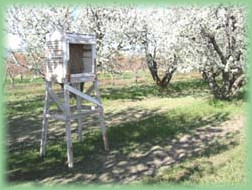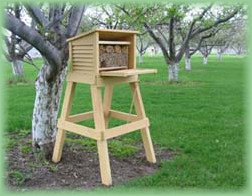Bees
 A high degree of pollination can be achieved using
blue orchard bees if basic management guidelines are followed. The first step
is to start with quality bees. Dormant bees are usually obtained in the fall
or winter months prior to the spring in which they are going to be used for
pollination. These bees are fully formed adults inside pupal cases, or cocoons,
within nesting tubes. Dormant Osmia can be purchased as either inspected
or uninspected bees. Inspected bees have been examined one at a time, and any
parasites, dead bees, and unnecessary debris have been removed from inside the
nesting tubes. Mud partitions that separate the individual bees inside the tubes
are removed to facilitate rapid emergence. The inspector also insures that the
cocoons are properly oriented within the tubes (click
here to see a sample). Lastly, the numbers of female and male bees
are indicated on the outer side of the inspected nest. A ratio of one female
to 1.5 males (40% females) is desirable for sufficient mating. Unmated females
will still produce nests and lay eggs but all of the offspring will be males.
A high degree of pollination can be achieved using
blue orchard bees if basic management guidelines are followed. The first step
is to start with quality bees. Dormant bees are usually obtained in the fall
or winter months prior to the spring in which they are going to be used for
pollination. These bees are fully formed adults inside pupal cases, or cocoons,
within nesting tubes. Dormant Osmia can be purchased as either inspected
or uninspected bees. Inspected bees have been examined one at a time, and any
parasites, dead bees, and unnecessary debris have been removed from inside the
nesting tubes. Mud partitions that separate the individual bees inside the tubes
are removed to facilitate rapid emergence. The inspector also insures that the
cocoons are properly oriented within the tubes (click
here to see a sample). Lastly, the numbers of female and male bees
are indicated on the outer side of the inspected nest. A ratio of one female
to 1.5 males (40% females) is desirable for sufficient mating. Unmated females
will still produce nests and lay eggs but all of the offspring will be males.
 Obtaining non inspected bees can be somewhat of
a gamble as there is no assurance as to what you are getting. The number of
female bees will be unknown and may possibly be zero in many of the tubes. You
could also be releasing parasites and diseases into your area. Because many
different types of bees and wasps also utilize the same nesting materials, it
is very possible that some nests may not even contain orchard mason bees.
Obtaining non inspected bees can be somewhat of
a gamble as there is no assurance as to what you are getting. The number of
female bees will be unknown and may possibly be zero in many of the tubes. You
could also be releasing parasites and diseases into your area. Because many
different types of bees and wasps also utilize the same nesting materials, it
is very possible that some nests may not even contain orchard mason bees.
Inspected orchard bees are not necessarily more
expensive than non inspected bees. Surprisingly, non inspected bees generally
cost more than inspected bees when prices from various suppliers are compared.
In early spring, dormant
blue orchard bees and empty nesting tubes should be placed in a free standing
field shelter. The purpose of the shelter is to concentrate the bees in a desired
area while providing protection from wind and rain. Small louvered shelters
on elevated stands work well in small orchards. The best locations to position
the shelter are on the north or west edge of the orchard. If the shelter is
located inside the orchard, it can be placed next to a tree or where a dead
tree has been removed so that it is out of the way of motorized equipment. Attaching
the shelter to the side of a house or other building is not recommended. The
shelter should be oriented to face the southeast direction so that the interior
contents of bees and tubes are exposed to morning sunlight.
 A high degree of pollination can be achieved using
blue orchard bees if basic management guidelines are followed. The first step
is to start with quality bees. Dormant bees are usually obtained in the fall
or winter months prior to the spring in which they are going to be used for
pollination. These bees are fully formed adults inside pupal cases, or cocoons,
within nesting tubes. Dormant Osmia can be purchased as either inspected
or uninspected bees. Inspected bees have been examined one at a time, and any
parasites, dead bees, and unnecessary debris have been removed from inside the
nesting tubes. Mud partitions that separate the individual bees inside the tubes
are removed to facilitate rapid emergence. The inspector also insures that the
cocoons are properly oriented within the tubes (click
here to see a sample). Lastly, the numbers of female and male bees
are indicated on the outer side of the inspected nest. A ratio of one female
to 1.5 males (40% females) is desirable for sufficient mating. Unmated females
will still produce nests and lay eggs but all of the offspring will be males.
A high degree of pollination can be achieved using
blue orchard bees if basic management guidelines are followed. The first step
is to start with quality bees. Dormant bees are usually obtained in the fall
or winter months prior to the spring in which they are going to be used for
pollination. These bees are fully formed adults inside pupal cases, or cocoons,
within nesting tubes. Dormant Osmia can be purchased as either inspected
or uninspected bees. Inspected bees have been examined one at a time, and any
parasites, dead bees, and unnecessary debris have been removed from inside the
nesting tubes. Mud partitions that separate the individual bees inside the tubes
are removed to facilitate rapid emergence. The inspector also insures that the
cocoons are properly oriented within the tubes (click
here to see a sample). Lastly, the numbers of female and male bees
are indicated on the outer side of the inspected nest. A ratio of one female
to 1.5 males (40% females) is desirable for sufficient mating. Unmated females
will still produce nests and lay eggs but all of the offspring will be males.